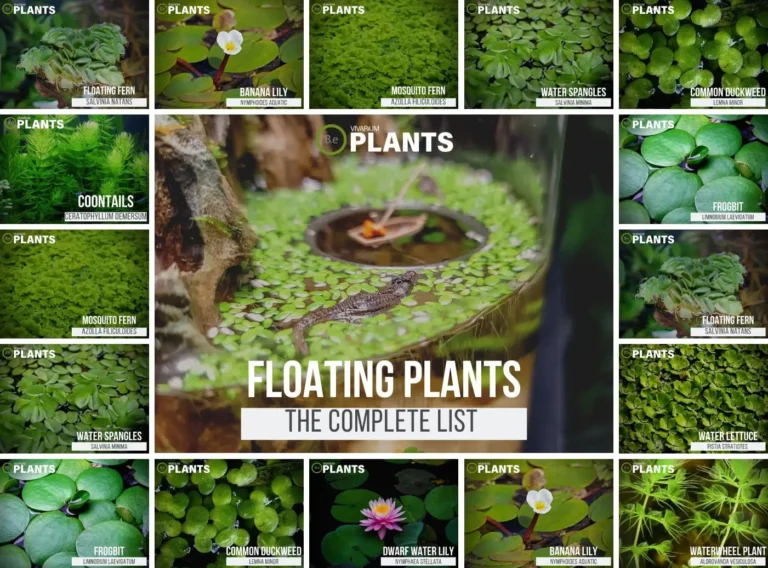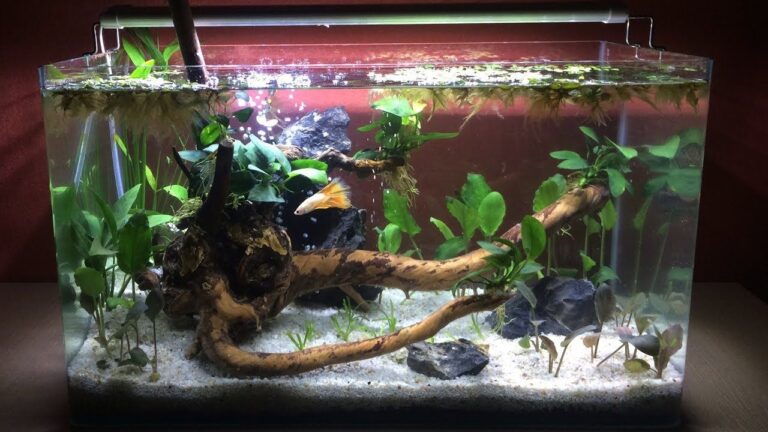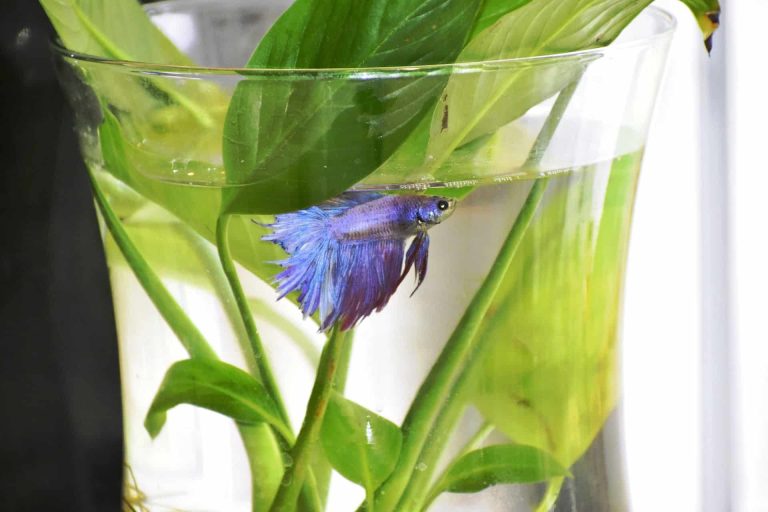How to Plant Live Plants in Aquarium: Expert Tips & Tricks
To plant live plants in an aquarium, first choose suitable plants and prepare the substrate. Then, plant the roots gently.
Live plants enhance the beauty and health of aquariums. They provide oxygen, reduce algae, and create a natural habitat for fish. Selecting the right plants is crucial for success. Opt for species that match your tank’s conditions, such as light and temperature.
Use a nutrient-rich substrate to support healthy growth. Ensure the plants are free from pests and diseases before introducing them to the tank. Plant them carefully, ensuring roots are fully covered. Maintain a regular care routine, including proper lighting, fertilization, and water changes. This approach guarantees a thriving, vibrant aquatic environment.
:strip_icc()/beautiful-planted-freshwater-aquarium-1196061822-67ec1dbf927b4dadb5ea52cb8cd3bade.jpg)
Credit: www.thesprucepets.com
Choosing The Right Plants
Selecting the right plants for your aquarium is crucial. The right plants ensure a healthy and attractive underwater environment. Some plants are easier to care for, while others require more attention.
Popular Aquarium Plants
Here are some popular plants that thrive well in aquariums:
- Anubias: Hardy and low maintenance.
- Java Fern: Can grow in low light conditions.
- Amazon Sword: Perfect for beginners.
- Hornwort: Fast-growing and great for oxygenation.
Factors To Consider
Consider these factors when choosing plants:
| Factor | Description |
|---|---|
| Light | Some plants need high light, others low. |
| Substrate | Choose the right substrate for roots. |
| Water Temperature | Ensure the water temperature suits the plants. |
| Fish Compatibility | Some fish eat or uproot plants. |
| Maintenance | Consider the maintenance level you can handle. |
Choosing the right plants can make your aquarium vibrant and healthy. Always research the needs of each plant before adding them to your tank.
Preparing The Aquarium
Before planting live plants in your aquarium, prepare the tank properly. This ensures a healthy environment for your plants. Follow these steps to get started.
Cleaning The Tank
Start by thoroughly cleaning the tank. Make sure it’s free from any dirt or chemical residues. Use warm water and a clean sponge. Avoid using soap or detergents, as they can harm fish and plants.
- Rinse the tank with warm water.
- Scrub the glass with a clean sponge.
- Ensure all soap residues are completely removed.
Once cleaned, let the tank air dry. This ensures no harmful substances remain.
Adding Substrate
Next, add the substrate to your aquarium. The substrate is the material at the bottom of the tank. It provides nutrients for your plants and anchors their roots.
Choose a nutrient-rich substrate. Options include gravel, sand, or specialized plant soil.
| Substrate Type | Benefits |
|---|---|
| Gravel | Provides good water flow and root anchorage. |
| Sand | Ideal for delicate roots. |
| Plant Soil | Rich in nutrients, supports plant growth. |
- Rinse the substrate to remove dust.
- Layer the substrate evenly at the bottom.
- Aim for a depth of 2-3 inches.
Proper substrate setup ensures your plants thrive in a healthy environment.
Water Quality Essentials
Ensuring the right water quality is crucial for thriving aquarium plants. The key factors include pH levels and water hardness. Let’s explore these elements to create a plant-friendly environment.
Ph Levels
The pH level of water affects plant health. Most aquarium plants prefer a pH between 6.5 and 7.5. You can measure pH using a test kit. Adjusting pH levels is simple. Use pH increasers or decreasers. Avoid sudden changes to prevent plant stress.
Water Hardness
Water hardness is another vital factor. It refers to the amount of dissolved minerals. Most plants thrive in soft to moderately hard water. Hardness is measured in degrees (dGH). Optimal range for plants is 4-12 dGH.
Here is a table showing water hardness levels:
| Water Hardness (dGH) | Category |
|---|---|
| 0-3 | Very Soft |
| 4-7 | Soft |
| 8-12 | Moderately Hard |
| 13-18 | Hard |
| 19+ | Very Hard |
To adjust water hardness, use commercial softeners or add minerals. Consistency is key for plant growth. Regular monitoring ensures a balanced environment.

Credit: www.algone.com
Lighting Requirements
Proper lighting is crucial for the health of live plants in your aquarium. It helps plants perform photosynthesis, which is essential for their growth and oxygen production. Understanding the different types of aquarium lights and their duration will ensure your plants thrive.
Types Of Aquarium Lights
Choosing the right type of light is important. Here are some common options:
- Fluorescent Lights: These are energy-efficient and provide a broad spectrum of light.
- LED Lights: Popular for their long lifespan and customizable settings.
- Metal Halide Lights: Ideal for deeper tanks, but they produce more heat.
Light Duration
The duration of light exposure affects plant growth. Here are some guidelines:
- 8-10 hours: Recommended for most freshwater plants.
- 10-12 hours: Suitable for high-light plants needing more photosynthesis.
- Less than 8 hours: May lead to poor plant growth.
Use a timer to maintain a consistent light schedule. This helps mimic natural daylight cycles and promotes healthy plant growth.
Planting Techniques
Planting live plants in an aquarium can enhance its beauty. It also helps to create a balanced ecosystem. Different types of plants require unique planting techniques. This section will guide you on how to plant rooted and floating plants.
Rooted Plants
Rooted plants need substrate to grow. Follow these steps to plant them:
- Choose a Substrate: Use nutrient-rich substrate like aquarium soil.
- Prepare the Plant: Trim damaged roots and leaves.
- Plant the Roots: Dig a small hole in the substrate. Place the plant’s roots in the hole. Gently cover the roots with substrate.
- Anchor the Plant: Use small rocks if needed to keep the plant upright.
Floating Plants
Floating plants do not need substrate. They float freely on the water surface. Here are some tips for planting floating plants:
- Rinse the Plant: Remove any debris or pests.
- Place in Aquarium: Gently place the plant on the water surface. Ensure it has space to grow.
- Monitor Growth: Floating plants may block light. Trim them regularly.
Below is a comparison table of rooted and floating plants:
| Feature | Rooted Plants | Floating Plants |
|---|---|---|
| Substrate Needed | Yes | No |
| Planting Method | Dig and Cover Roots | Place on Water Surface |
| Maintenance | Low to Medium | High (Trimming needed) |
Nutrient Management
Proper nutrient management is essential for healthy aquarium plants. Ensuring your plants get the right nutrients helps them grow strong and vibrant. Below, we will discuss two main aspects: fertilizers and CO2 injection.
Fertilizers
Fertilizers provide essential nutrients to aquarium plants. There are two main types: liquid and substrate-based fertilizers.
- Liquid Fertilizers: These are added directly to the water. They supply nutrients quickly and are easy to use.
- Substrate Fertilizers: These are placed in the substrate. They provide a slow and steady release of nutrients.
It’s important to follow the dosage instructions. Over-fertilizing can harm your plants and fish.
Co2 Injection
CO2 is vital for photosynthesis in plants. In most aquariums, natural CO2 levels are not enough. CO2 injection helps maintain optimal levels.
| CO2 Injection Methods | Advantages |
|---|---|
| Pressurized Systems | Precise control, suitable for large tanks |
| DIY Systems | Cost-effective, suitable for small tanks |
Monitoring CO2 levels is crucial. High CO2 can harm fish.
Maintaining Plant Health
Healthy plants create a vibrant and balanced aquarium ecosystem. Proper care ensures your plants thrive. This section focuses on the essential tasks to maintain plant health.
Pruning And Trimming
Pruning and trimming are crucial for plant health. Regular pruning helps plants grow better. It also keeps them from overtaking the tank.
Use clean, sharp scissors for pruning. Always cut just above a leaf node. Remove any dead or decaying leaves. This prevents algae and disease.
Trimming encourages new growth. It also helps shape the plant. Keep an eye on fast-growing plants. They need more frequent trimming.
Identifying Plant Diseases
Identifying plant diseases early is vital. Look for signs like yellowing leaves, black spots, or holes. These can indicate nutrient deficiencies or infections.
Common plant diseases include:
- Algae Overgrowth: Algae can smother plants. Reduce light and nutrients to control it.
- Fungal Infections: Fungi can cause black spots. Remove affected leaves immediately.
- Nutrient Deficiencies: Yellow leaves often mean a lack of nutrients. Add fertilizers as needed.
Use a table to keep track of plant health:
| Symptom | Possible Cause | Solution |
|---|---|---|
| Yellowing Leaves | Nutrient Deficiency | Add Fertilizers |
| Black Spots | Fungal Infection | Remove Affected Leaves |
| Holes in Leaves | Pest Damage | Inspect and Remove Pests |
Regular monitoring and maintenance ensure plant health. This keeps your aquarium beautiful and balanced.

Credit: www.aquariumcoop.com
Aquascaping Ideas
Aquascaping is the art of arranging plants, rocks, and driftwood in an aquarium. It creates beautiful underwater landscapes. This section provides aquascaping ideas. Learn how to create natural landscapes and incorporate hardscapes into your aquarium.
Creating Natural Landscapes
Creating natural landscapes in your aquarium can mimic real-world environments. Start by choosing plants that match the look you want. For a forest look, use tall, leafy plants like Amazon Swords. For a grassy field, use short plants like Dwarf Hairgrass.
Use different plant heights to create depth. Place tall plants at the back and short plants at the front. This makes the tank look larger.
Consider adding floating plants. They provide shade and reduce algae growth. Some good choices are Duckweed and Frogbit.
| Plant Type | Ideal Placement |
|---|---|
| Amazon Swords | Back of the tank |
| Dwarf Hairgrass | Front of the tank |
| Duckweed | Floating |
| Frogbit | Floating |
Incorporating Hardscapes
Hardscapes are non-living elements like rocks and driftwood. They add structure and interest to your aquarium. Choose rocks and wood that are safe for fish. Avoid sharp edges to prevent injuries.
Place rocks and wood in groups. This looks more natural. Create caves and hiding spots for fish. They love exploring and hiding. Use driftwood to create focal points. It adds a rustic look.
Combine different hardscapes for variety. Use large rocks with small pebbles. Mix driftwood with mosses. This makes the tank look more dynamic.
- Rocks: Choose smooth, non-toxic rocks.
- Driftwood: Use boiled driftwood to remove toxins.
- Mosses: Attach mosses to hardscapes for a natural look.
Frequently Asked Questions
How Do I Prepare Aquarium Plants?
To prepare aquarium plants, rinse them thoroughly in dechlorinated water. Remove any damaged leaves. Trim the roots slightly to encourage new growth.
What Substrate Is Best For Aquarium Plants?
The best substrate for aquarium plants is nutrient-rich. Options include specialized plant substrates, soil, or gravel with root tabs.
How Do I Plant Aquarium Plants?
To plant aquarium plants, dig a small hole in the substrate. Gently place the plant roots in the hole. Cover the roots with substrate.
How Much Light Do Aquarium Plants Need?
Aquarium plants generally need 8-12 hours of light daily. Use a full-spectrum LED light for best growth results.
Conclusion
Planting live plants in your aquarium enhances its beauty and creates a healthy environment for fish. Follow the steps carefully to ensure optimal growth. Regular maintenance is crucial for vibrant plant life. Enjoy the natural aesthetics and benefits of a well-planted aquarium.
Happy aquascaping!





